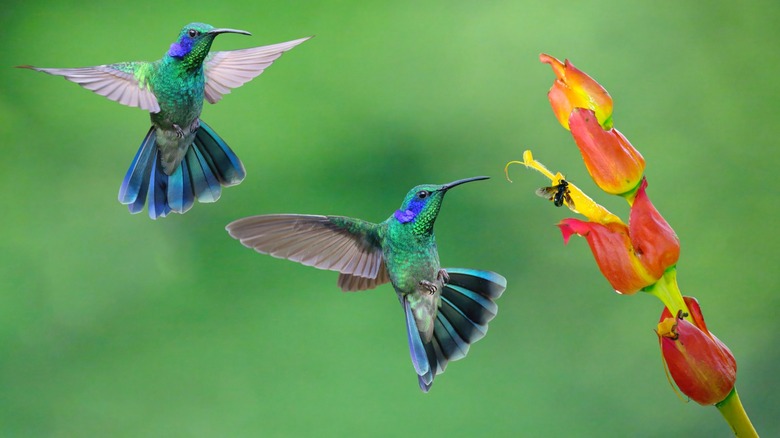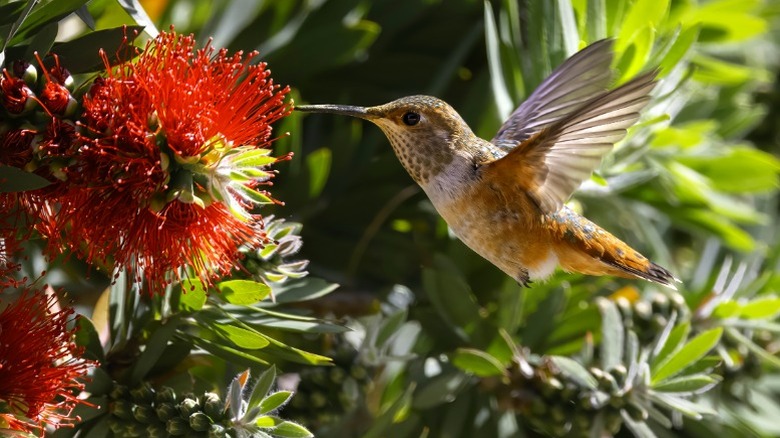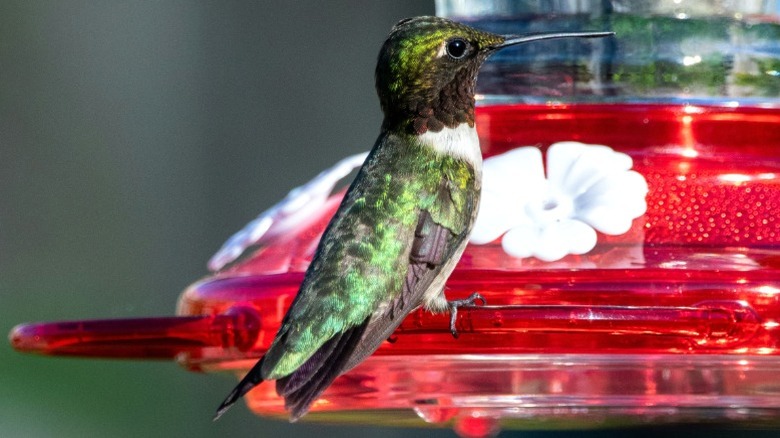Essential Features For Attracting Hummingbirds To Your Garden
Even after you put in the hard work to manage a diverse garden, there's still the matter of bringing in beneficial creatures for the finishing touch. A plethora of pollinators is nature's ultimate seal of approval, rewarding you richly for a job well done. Bees, butterflies, and other helpful critters promote thriving plants while bringing vibrant interest that makes the space exponentially more enjoyable. Yet, even the most well-tended garden may not be enough to coax desirable visitors. When you want to bring hummingbirds to the yard, a smart choice of features is non-negotiable.
Like any animal, hummingbirds need food, water, and safe places to rest before they feel comfortable calling a garden home. Fail to meet their needs in any aspect, and it isn't hard to understand why hummingbirds will steer clear of your yard. Take stock of your garden and diagram its design. You likely won't need a complete overhaul. Find a few select plants and features to add in the right places. Ideally, you can bring the birds to a visible area where you can watch them through a window or from your porch. Once you succeed in attracting them, it's easier to keep them coming back. Hummingbirds have exceptional memories, so make it worth their while, and they'll stake their claim in your garden year after year.
Garden plant tips to attract more hummingbirds
More than anything, plants will anchor any effort to draw in hummingbirds with nectar, nesting, and perches. Check online resources, naturalist societies, and local nurseries for info on native plants for a sustainable approach to attracting hummingbirds. Generally, they prefer bee-deterring red and pink tubular flowers such as bee balm.
Pick several plant varieties that will bloom at different points throughout the year. Your hummingbirds can then have a reliable supply from early spring all the way through fall. Use trellises, planter boxes, and other features to make tiers that allow for optimal visibility. Avoid using pesticides, as you'll need insects and spiders for them to consume for protein. Insecticidal chemicals can also harm the hummingbirds themselves.
Alongside food sources, plant shrubs and deciduous trees. Proper nesting sites and perches will make your hummingbirds feel at home. Large trees are preferable, but several smaller ornamental trees can work in limited spaces. You can also prop up dead branches or use a DIY swing for perching to bring hummingbirds to the garden. Position them within about 10 to 20 feet of your hummingbird area, and vary their exposure. Put some in sunny, open areas with good visibility and others in more sheltered areas to help the birds hide away.
Feeders and fun features to bring hummingbirds to the garden
While you're waiting for your plants to grow, put in birdbaths and feeders that will offer immediate benefits to nearby birds. Birdbaths provide a water and bathing spot. Set up a shallow basin, or install garden misters and sprinklers or solar fountains to create droplets for the birds to flit through. Put drippers over leafy plants to let water accumulate and give them a damp area to bathe.
Set up hummingbird feeders a few weeks before the first expected sighting of the season. Use a simple DIY nectar of granulated sugar mixed with water in a 1 to 4 ratio. Boil the mixture for a few minutes before putting it in the feeder to slow potential microbial growth. Clean the feeders at least twice a week with a vinegar and water solution during the warmer months. You should change the food at a similar frequency or whenever it looks the least bit cloudy.
Hummingbirds can be vulnerable while feeding and frolicking. Position your feeders and baths in safe areas where you can dissuade predators and pests like cats and praying mantises you don't want near your hummingbird feeders. Hummingbird feeders should sit in the shade to keep the nectar from fermenting too quickly, but you also shouldn't place them too close to each other. Hummingbirds will resource guard, so keeping the feeders out of sight from one another can prevent conflict.


